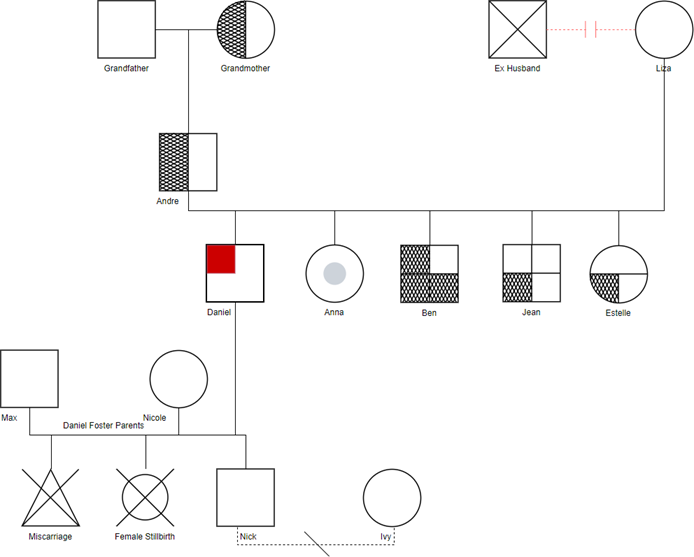Unraveling Family Histories: The Comprehensive Guide to Genograms
Introduction
Family trees have long been used as visual representations of one’s lineage, showcasing names, relationships, and connections through generations. While traditional family trees provide a basic overview, they often fall short when it comes to capturing the intricate dynamics, major events, and unique relationships within a family. This is where genograms step in—a more detailed and insightful approach to mapping out family histories.
Understanding Genograms

A genogram is not just a family tree; it’s a dynamic and comprehensive family map that utilizes special symbols to convey a wealth of information. This innovative tool goes beyond the surface, delving into the nuances of family dynamics, relationships, and major life events. By incorporating symbols, colors, and annotations, a genogram provides a more holistic and layered perspective on a family’s history.
Symbolism in Genograms
Unlike traditional family trees that might feature simple lines connecting names, genograms use a variety of symbols to represent different aspects of family relationships. For example, circles and squares denote gender, while different line styles indicate diverse types of relationships—solid lines for biological connections, dashed lines for adoptive relationships, and so on. This level of detail allows for a nuanced portrayal of family structures.
Capturing Complex Relationships
One of the key strengths of genograms lies in their ability to capture complex relationships that conventional family trees might overlook. For instance, consider the scenario of twins, Tom and Mary. While a traditional family tree might simply list them as siblings, a genogram can specifically denote their twin status, offering a richer understanding of their connection.
Biological vs. Adoptive Relationships
Genograms excel in elucidating the intricacies of family structures, particularly when it comes to distinguishing between biological and adoptive relationships. This can be crucial in unraveling family mysteries or understanding the unique dynamics that arise in blended or adoptive families. By using distinct symbols, genograms provide clarity on the origin of relationships, offering a more accurate portrayal of the family unit.
Mapping Major Life Events
Beyond relationships, genograms are invaluable tools for documenting major life events within a family. Births, deaths, marriages, divorces, and other significant milestones can be incorporated into the genogram, creating a comprehensive timeline of the family’s history. This historical perspective allows for a deeper understanding of how these events have shaped the family’s dynamics over time.
Application in Counseling and Therapy
Genograms have found widespread use in counseling and therapy settings. Therapists use these visual representations to explore family dynamics, identify patterns, and uncover potential sources of conflict or tension. The depth of information provided by genograms enables therapists to tailor interventions and strategies that address specific family challenges.
Empowering Genogram Creation with Powerful Tool
In the ever-evolving landscape of online diagram software, VP Online emerges as a powerful tool for creating detailed and visually appealing genograms. Whether you’re a novice or an experienced user, VP Online offers a seamless experience with its rich set of genogram tools, symbols, and templates. This software allows users to draw and discuss genograms effortlessly, providing a versatile and accessible platform for mapping out complex family histories.
Key Features of VP Online Genogram Software:
- User-Friendly Interface: VP Online boasts an intuitive and user-friendly interface, making genogram creation a simple and fast process. Whether you are a beginner exploring family history or a professional delving into intricate relationships, the software’s design ensures a smooth experience for all users.
- Rich Set of Tools and Symbols: The software comes equipped with a diverse array of genogram tools and symbols, allowing users to capture the complexity of family dynamics. From circles and squares denoting gender to various line styles representing different types of relationships, VP Online ensures that users can convey detailed information through a comprehensive set of symbols.
- Online Accessibility: One of the standout features of VP Online is its online accessibility. The software runs seamlessly on any device and browser, offering users the flexibility to create and edit genograms from anywhere with an internet connection. This adaptability ensures that users can work on their genograms at their convenience, whether at home, in the office, or on the go.
- Collaborative Capabilities: VP Online facilitates collaboration by allowing users to draw and discuss genograms in real-time. This collaborative feature is particularly beneficial for family research, counseling sessions, or academic projects where multiple individuals may contribute to the creation and analysis of genograms.
Genogram Templates for Every Need:
VP Online goes a step further by providing a diverse collection of genogram templates. Whether users are looking to develop a genogram from scratch or seeking inspiration, the software offers a range of templates to suit various needs. These templates serve as a starting point, streamlining the genogram creation process and catering to different preferences and requirements.
Conclusion
In the realm of family history mapping, genograms stand out as powerful tools that go beyond the limitations of traditional family trees. By incorporating symbols and detailed annotations, genograms offer a nuanced and comprehensive perspective on family dynamics, relationships, and major life events. Whether used for personal reflection, academic research, or therapeutic purposes, genograms provide a rich tapestry through which to explore and understand the intricate threads of family histories.

